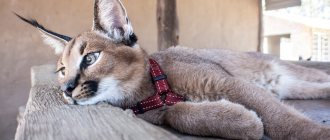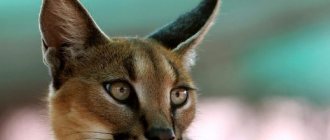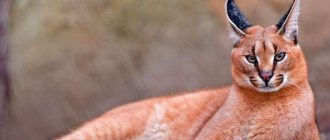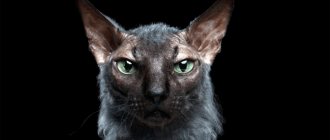The caracal is nothing more than a wild cat with a streamlined, slender body, covered with short hair of a golden-reddish hue, and also with a unique pattern in the muzzle area. The caracal is also called the desert lynx, although the lynx is distinguished by shorter limbs, as well as the presence of a peculiar pattern on the coat, in the form of stripes and spots.
These are the fastest and also the largest wild cats on the African continent. Before modern caracals acquired that appearance and that anatomical structure of the body, about 4 tens of millions of years passed.
Origin and habitat of the caracal
The name caracal is believed to come from the Turkish “kara kulak”, which means “black ear”. Officially, there are 9 subspecies, classified by country of residence.
Caracal has been known since ancient times. For example, Indian princes tamed big cats and used them to hunt small game. Since the animal resembles a lynx in appearance, it was often mistakenly called that, although these 2 predators have no relationship either in terms of species or habitat.
The name caracal is believed to come from the Turkish "kara kulak", which means "black ear"
The caracal is considered a rare predator of the cat family, on the verge of extinction. It is listed in the International Red Book. The natural habitat of these animals: deserts and savannas of Africa, Asia Minor and Central Asia, hilly areas of Israel, forests of Pakistan. It is also found on the Arabian Peninsula, the coast of the Caspian Sea, in Southern Turkmenistan and Uzbekistan.
Psychology
It is important to remember that the caracal, like the Pallas cat , was and remains a predator.
Therefore, consistency and clear order in requirements are very necessary for his upbringing.
We need to help the kitty learn subordination and develop competent rules of behavior for her.
Otherwise, this lynx cat will delight its owners with the following qualities:
- Kindness. In terms of the degree of softness of character, the caracal can confidently compete with some breeds of completely domestic cats such as savannah or pixie-bob .
- Equilibrium. Caracals are not known for sudden bursts of activity followed by 15 hours of rest.
- Energy. Cats need certain physical activity, otherwise they can be downright mischievous.
Caracals jealously protect their territory from the invasion of other animals. But lynx cats get along very well with pets living under the same roof.
- Playfulness. They are happy to take part in children's games, this will be a great opportunity for them to burn off their energy.
- Owner's instinct. Caracals jealously protect their territory from the invasion of other animals. But lynx cats get along very well with pets living under the same roof. Just don't keep small rodents like degu squirrels or lemmings .
- Curiosity. Who will be the first to run to “open” the door when he hears the bell, or who will tirelessly look for the source of the rustling in the bushes? Of course it's your caracal cat! Photos and videos dedicated to these animals are full of the most amusing stories.
Baby caracal - so innocent and defenseless
Appearance and physiology
Caracals are slender cats of medium size, an adult can weigh up to 20 kg, males usually weigh 13-18, females - about 11 kg. The body length of the predator is 62-90 cm, not counting the tail, which grows up to 34 cm. The height of the cat is up to 40 cm.
The caracal is considered a rare predator of the cat family, on the verge of extinction
The main distinctive qualities of caracals:
- Long black tassels on large, tapering ears; in young individuals they are much shorter. It is believed that this structure of the ears helps animals in camouflage and communicate with each other.
- Reddish-sandy, brown, brick-red coat color. Specimens with black fur were found. This sign depends on the habitat of the animal. The coat is short and lies close to the body.
- The color is uniform throughout the body, lighter on the neck, chest and belly, decorated with many small spots. On the face there are pronounced transitions of shades from lighter to richer, it looks quite attractive. The outer surface of the ears is black. Newborn kittens are darker, with red spots on the belly, which disappear as they grow older.
- The ability to jump vertically from a standing position to a height of more than 3 m, which allows it to hunt easily. This quality is due to the fact that caracals have longer hind legs than their front legs.
- Vision and hearing are very well developed.
Scientific classification
- Kingdom: Animalia (animals)
- Phylum: Chordata
- Class: Mammalia (mammals)
- Order: Carnivora (predatory)
- Family: Felidae (felines)
- Genus: Caracal (caracals)
- Species: Caracal caracal (caracal)
Buffon in 1761 chose the name "caracal" in connection with the Turkic name for the animal "karrah-kulak" or "kara-kulak", which means a cat with black ears . In Afrikaans (an African language, a dialect of Dutch), this cat is called “rooikat” - “red cat”. Other names for caracal: African lynx, desert or steppe lynx.
Gallery: caracal cat (25 photos)
Varieties
There are 9 subspecies of caracal:
- West African caracal (Caracal caracal poecilictis) - found in Central and Western Africa, Senegal, Nigeria;
- Indian caracal (Caracal caracal schmitzi) - lives in Western Asia, Iran, Saudi Arabia and India;
- common caracal (Caracal caracal caracal) - found in Central and Southern Africa;
- Gabonese caracal (Caracal caracal lucani) – found in Gabon, Congo, Angola;
- Namibian caracal (Caracal caracal damarensis) – lives in Namibia;
- North African caracal (Caracal caracal algira) – lives in North Africa;
- Nubian caracal (Caracal caracal nubica) - found in Ethiopia and Sudan;
- Transvaal caracal (Caracal caracal limpoensis) - found in Botswana and northern South Africa;
- Turkmen caracal (Caracal caracal michaelis) – lives in Turkmenistan.
The appearance of offspring
The pregnancy of a predatory cat lasts 68-81 days, caracal kittens weigh 195-250 g at birth, the litter usually consists of 1-6 babies. Adult cats are capable of killing their offspring.
A caracal kitten begins to open its eyes slightly within the first day after birth; they open completely on days 6-10. At 10 weeks, the female stops breastfeeding her cubs, continuing to care for them for about a year. 3 weeks after birth, the mother moves the kittens to another den and continues to periodically change habitats.
Health, life expectancy
Even in the wild, Caracals live up to 13-15 years, and in a cozy home - up to 18-20. They are distinguished by good health and endurance. There are no characteristic hereditary diseases. They only tolerate cold poorly, because their homeland is hot savannahs, steppes and deserts. In the autumn-winter season, reduce the duration of daily walks outside.
At the beginning of life, the pet is given mandatory vaccinations twice:
- 10-12 weeks - polyvalent vaccination (against several diseases at once), after 3 weeks - revaccination;
- 12-13 weeks – rabies vaccination.
Additionally, vaccinations are carried out against panleukemia, rhinotracheitis, and calcevirosis. Do not vaccinate while your pet is sick.
About the possibility of keeping a caracal at home
In order for a caracal to grow up tame and kind at home, you need to follow the recommendations of experts:
- buy a kitten only from a home nursery;
- the age of the purchased pet should not exceed 6 months;
- from the earliest period of the animal’s life, constantly contact it;
- castration of cats is desirable if they are not planned for breeding;
- if there are children under 5 years of age in the house, the purchase should be postponed;
- It is necessary to have documents for the pet proving its origin.
Features of care
Combing
A caracal should be combed no more than once a week using a furminator . Bathe as needed if the kitty is very dirty.
Although lynx cats, just like Turkish Vans , love water very much and will not refuse to play in the bath with rubber balls.
As for the claws, usually in nurseries they are removed with a laser on the front legs. These kitties don't like to have their nails done.
Therefore, if there are claws, it is better to organize a good scratching post in the form of a log inclined towards the corner.
Ears and eyes should be inspected once a week and cleaned as needed.
The feline nature of the caracal requires control - walking must be done while keeping the animal on a leash
Walk
There is a class of domesticated animals that are conventionally called domestic, among them is the caracal.
Photos (domestic or wild versions) of these cats often demonstrate their love of freedom.
It is, of course, quite possible to keep this lynx cat, like the Norwegian forest cat,
In this case, if the weather is good, you need to walk with her more often.
The cat nature of the caracal requires control - walking must be done while keeping the animal on a leash.
It is worth purchasing a flea and tick collar - this way you will protect your pet from annoying parasites.
The ideal option for a cat is an enclosure in a country house.
It’s good if the spacious enclosure is filled with different shelves and steps on which the mustachioed hunter will jump, satisfying his need for physical activity.
An aviary option for keeping a cat in a country house is ideal.
Nutrition
The bulk of a caracal's diet should be raw, lean meat.
These cats obtain vitamins and microelements by eating the insides of their “prey.”
A suitable feeding option for kitties would be whole bird or rodent carcasses, plus raw meat.
For example, it could be 2 rats or 4 mice and half a kilo of meat. You should give raw sea fish no more than once a week.
Important! Up to a year, the caracal is given two meals a day. For ideal bowel function after a year, you need to give food only once a day.
Also, every week the kitty should have a fasting day - do not give any meat.
Naturally, such fasting is contraindicated for pregnant and lactating females.
Caracal is a real hunter
The diet of caracals should not include:
- Food from your table prepared for people;
- Sweets and confectionery;
- Salty, hot, spicy;
- Sausages, sausages and various smoked meats.
feed your lynx cat dry food , but the product must be of the highest quality.
When choosing food, it is better to consult with several specialists who are well versed in the breed.
Important! With any type of feeding, uneaten food must be removed.
The caracal needs certain physical activity, otherwise it can be downright mischievous.
Communication
three of these perceptual systems to communicate . It is assumed that the position of the ears is used for intraspecific communication.
When threatened, the caracal slowly approaches the enemy, holding its head below shoulder level, ears turned outward, and tail twitching. At a higher threat level, it holds its mouth open with teeth exposed and ears pinned back, hissing or spitting.
The caracal is known to exhibit a range of vocalizations, including purrs, growls, hisses and meows. Zoologists additionally mention a leopard-like cry that adults sometimes make. Young kittens emit a high-pitched cry, reminiscent of the cry of a Cape sparrow.
Steppe lynxes also interact through urine spraying and scent marking. They have buccal, mental and anal scent glands that allow individuals to mark territories and demonstrate their receptivity.
Lifestyle
Photo: Christiaan Viljoen
Although the caracal is primarily nocturnal , activity levels are bimodal and dependent on ambient temperature rather than photoperiod. Travel speed usually increases at night. This predator prefers temperatures below 20 °C, and daytime activity increases on cool, cloudy days. Males move 5-15 km daily, and females move 2.5-10 km per day.
The caracal prefers solitude , and only occasionally are the movements of two adults or females accompanied by their offspring observed.
Males exhibit throwing behavior by moving their paws across wet sand after urinating, or mark by raising their tail vertically and spraying urine onto vegetation and logs around their territory. Females also exhibit throwing behavior, although not as frequently as males. Both sexes use "tree scratches" to mark their territories.











